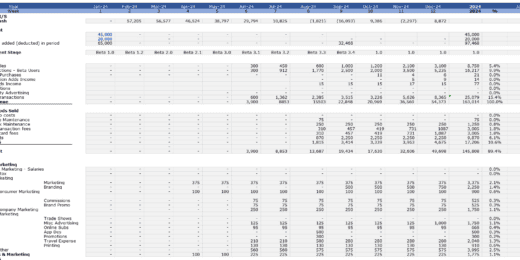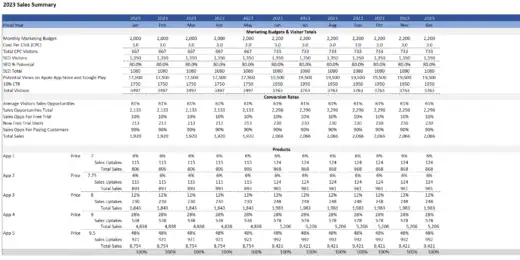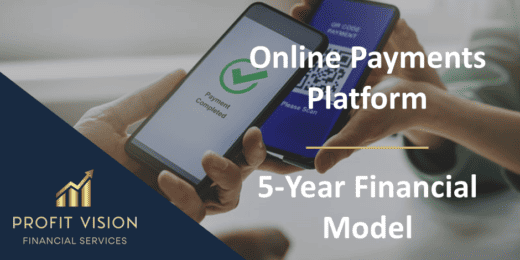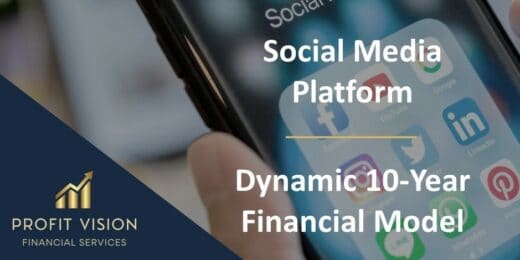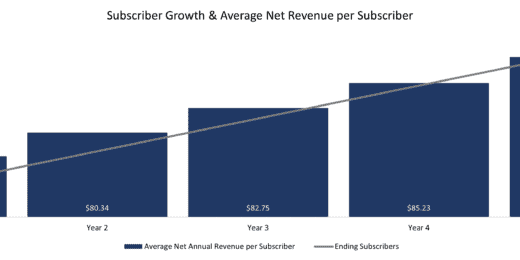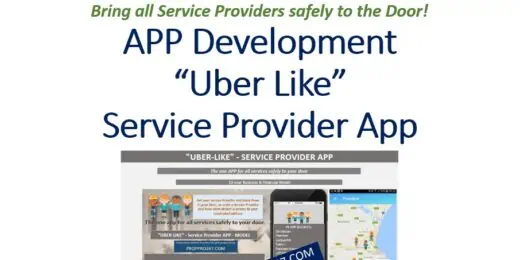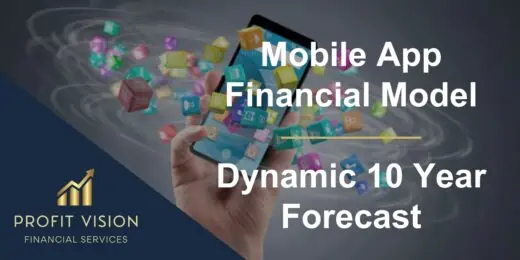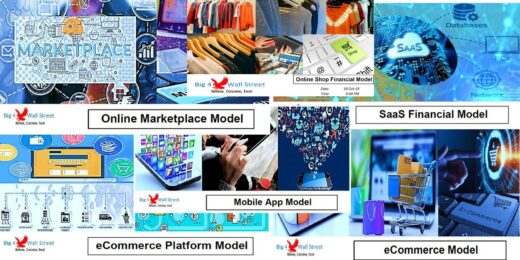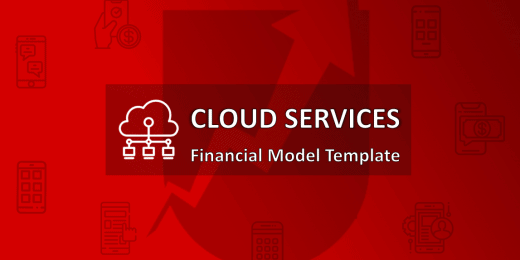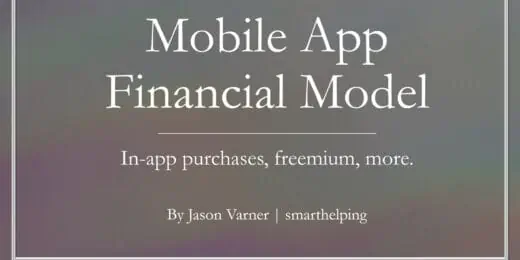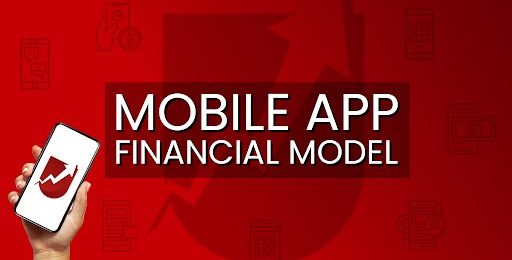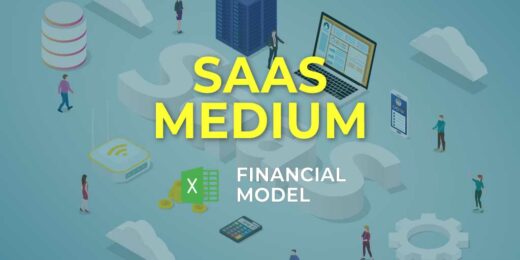Mobile Apps
Fintech Mobile App Financial Model
A comprehensive editable, MS Excel spreadsheet for tracking Fintech Mobile…
Mobile App Development Financial Model
A comprehensive editable, MS Excel spreadsheet for tracking Mobile App…
Buy Now Pay Later (BNPL) Platform – 5 Year Financial Model
Financial Model presenting an advanced 5-year financial plan for a…
Online Payments Platform – 5 Year Financial Model
Financial Model providing an advanced 5-year financial plan for a…
Subscription Business – 10 Year Financial Model
Financial Model providing a 10-year financial plan for a startup…
Bundle – Business Financial Forecasting Models
The purpose of this Bundle of Business Forecasting and Financial…
Social Media Platform – Dynamic 10 Year Financial Model
Financial Model providing a dynamic up to 10-year financial forecast…
Mobile Applications (App) Monthly 3-Statement Business Plan with Return Calculation
Pro Forma Models created this model to prepare and analyze…
MOBILE APP FINANCIAL MODEL – Team Strategy FM
A modelling template that covers every aspect of the vast…
Mobile Notary Financial Model Excel Template
Mobile Notary Financial Model Based on years of experience at…
Service Provider APP (Uber-like) Business, Financial And Develop Tips Model 10 years
This Financial & Business Model is specific to the Service…
Online Business Financial Models Bundle
A collection of six Online Business Financial Models offered at…
Mobile App Financial Model – Dynamic 10 Year Forecast
Financial Model providing a dynamic up to 10-year financial forecast…
Mobile App Financial Model MEGA/GIGA + Video Tutorial
This simple, but powerful financial model in Excel helps you…
Restaurant Aggregator and Food Delivery Business Financial Model Template
Restaurant Aggregator and Food Deliver Business Plan Model is a…
Mobile App Business Case Financial Model Template
This financial model provides a comprehensive financial plan template for…
Mobile Application (APP) – 3 Statement Financial Model with 5 years Monthly Projection
This Mobile App Business Plan Model is a perfect tool…
Cloud Services Financial Model Excel Template (Fully-Vetted and Ready-to-Use)
Fully-Vetted Comprehensive Cloud Services Financial Model + Video Series +…
Startup or Existing Subscription Business Financial Projection 3 Statement Model
3 statement 5 year rolling financial projection Excel model for…
Web/Mobile App Startup/Existing Business Financial Projection 3 Statement Model
3 statement 5 year rolling financial projection Excel model for…
Mobile App Financial Model Excel Template (Fully Vetted and Ready-to-Use)
Fully-Vetted Comprehensive Mobile App Financial Model + Video Series +…
SaaS Metrics Dashboard Template Excel
SaaS Dashboard Template created in Excel spreadsheet format to assist…
SaaS Model Templates – Small Bundle Version
Get 3 SaaS financial model templates for SaaS startups with…
SaaS Model Templates – Big Bundle Version
Get 5 SaaS financial model templates for SaaS startups with…
Monthly Recurring Revenue SaaS Financial Model Excel Template
Check Monthly Recurring Revenue SaaS Financial Model. This well-tested, robust,…
SaaS Application Freetrial Financial Model Excel Template
Check SaaS Application Freetrial Pro-forma Template. Enhance your pitches and…
Online Businesses Financial Model Bundle
This is a collection of financial model templates for businesses…
Website / App Financial Model (Recurring Revenue Services)
A great tool to model out any recurring revenue service…
Financial Model for Mobile App | Mobile App Business Plan
The Mobile App Financial Plan Template in Excel allows you…
How To Start a Mobile App Business

How to start a mobile app business in today's digitally driven world represents a significant opportunity for entrepreneurs and innovators. With the increasing reliance on smartphones for everyday tasks, the demand for new and practical mobile applications is consistently growing.
A crucial step in how to start a mobile app business is creating a comprehensive mobile app business plan. This plan should outline critical aspects such as market analysis, target audience, app functionality, monetization strategies, marketing and launch plans, and financial projections. The importance of a well-structured and winning business plan cannot be overstated; it acts as a roadmap for your venture, helping to navigate the competitive and ever-evolving landscape of the mobile app industry.
Embarking on starting a mobile app business requires a strategic blend of innovative thinking and meticulous planning. Discover the essential steps and expert insights needed to transform your vision into a successful app venture by delving into our comprehensive guide.
Statistics About the Mobile App Industry
When thinking about how to start a mobile app business, the first question that comes to mind is how profitable the industry is. In 2022, the total market size of mobile apps worldwide was $420.80 billion. With a compound annual growth rate (CAGR) of 9.59%, its revenue is expected to reach $670.80 billion by 2027.
Around 8.93 million mobile applications are now available, with 250 million daily downloads. With 7.33 billion mobile phone users, it is unsurprising to hear that a mobile application development platform continues to strive and thrive despite the heavy development cost.
In today's fast-paced and technology-driven business environment, mobile applications have become crucial for many businesses to remain competitive. Mobile apps offer an efficient way for companies to connect with customers, streamline operations, and provide enhanced user experiences. Let's explore various business types and functions that particularly benefit from having a mobile app:
- E-commerce and Retail: Mobile apps provide a direct marketing channel to customers, offering them a convenient way to browse and purchase products. Features like push notifications can effectively engage customers with personalized offers and updates.
- Education and E-learning: Educational institutions and e-learning platforms use apps for delivering courses, tracking progress, and interactive learning, making education more accessible and personalized.
- Entertainment and Media: For entertainment businesses, having a mobile app means delivering content directly to consumers, be it streaming services, news, or gaming, keeping them engaged and subscribed.
- Food and Beverage Industry: For restaurants, cafes, and food delivery services, mobile apps allow for easy ordering, table reservations, and customer loyalty programs, enhancing the customer experience significantly.
- Financial Services: Financial services like banks, investment firms, and fintech companies use mobile apps for secure and convenient financial transactions, portfolio management, and real-time financial tracking, crucial for consumer retention and trust.
- Healthcare and Telemedicine: Mobile apps enable healthcare providers to offer teleconsultations, appointment scheduling, medication tracking, and patient record management, improving patient care and operational efficiency.
- Real Estate: Mobile apps allow real estate companies to showcase properties, schedule viewings, and provide virtual tours, enhancing the customer's property buying or renting experience.
- Travel and Hospitality: Hotels, airlines, and travel agencies can benefit from apps by providing easy booking options, check-ins, travel updates, and localized information, thus improving customer service and engagement.
A well-designed mobile app can be a game-changer for businesses across various industries. It improves customer interaction and service and enhances internal operations and data-driven decision-making.
What are Mobile Applications?
Mobile applications, commonly known as mobile apps, are software programs designed to run on mobile devices like smartphones and tablets. Blending with the functionality and limitations of mobile devices, they provide users with services similar to those accessed on PCs but with enhanced accessibility and convenience. Mobile applications can be pre-installed on devices or downloaded from app stores such as Google Play for Android and the Apple App Store for iOS.
Tracing the origins of the mobile app business, we find significant milestones that have shaped its current landscape. In 1997, Nokia introduced the 6110 model, which featured the preloaded game "Snake." This simple yet addictive game is widely regarded as the first mobile application, setting the stage for future app developments.
Fast forward a decade to 2007, a pivotal year in the mobile app history. This year marked the launch of the iTunes store, a precursor to Apple's revolutionary App Store. Additionally, 2007 saw the debut of the Netflix app, signaling the beginning of mobile applications' expansion beyond basic games to more complex and diverse functionalities. These historical landmarks highlight the evolution of mobile apps from simple entertainment to integral components of modern digital services and lifestyles.
In the context of businesses and financial professionals, mobile apps can be powerful tools for real-time financial monitoring, data analysis, and decision-making. They offer the convenience of accessing critical financial information and tools on the go, facilitating more agile and informed business decisions.
The Three Main Categories of Mobile Apps
Mobile apps have revolutionized how we interact with technology and are broadly categorized into native apps, web apps, and hybrid apps. Each category offers distinct features, advantages, and limitations, catering to different needs and user experiences.
- Native Apps: These are applications developed for a specific platform or operating system, utilizing platform-specific programming languages. For example, native apps for iOS are typically written in Swift or Objective-C, while those for Android are developed in Java or Kotlin. The primary advantage of native apps is their high performance and smooth user experience, as they are optimized for the hardware they run on. This results in better access to device features like the camera, microphone, GPS, and accelerometer. Famous examples of native apps include WhatsApp, Spotify, and Pokémon GO. Each of these apps is designed to provide a seamless user experience on their respective platforms, leveraging the full potential of the device's capabilities.
- Web Apps: Web apps are essentially websites that are designed to look and feel like native apps but are accessed via a web browser. They are developed using standard web technologies such as HTML, CSS, and JavaScript. The key benefit of web apps is their cross-platform compatibility, meaning they can run on any device with a web browser, regardless of the operating system. However, they are generally slower and less intuitive than native apps and have limited access to device-specific features. Famous examples of web apps include Google Docs, Netflix, and Flipboard. These apps offer a convenient, platform-agnostic experience accessed from any device with an internet connection.
- Hybrid Apps: Hybrid apps are a blend of native and web apps. They are built using web technologies like HTML, CSS, and JavaScript and then wrapped in a native container using platforms like Apache Cordova (formerly PhoneGap) or Ionic. This approach allows them to access device capabilities similar to native apps while offering web app development flexibility. Hybrid apps can be distributed through app stores just like native apps, and they offer a balance between performance and development efficiency. Famous examples of hybrid apps include Instagram, Uber, and Twitter. These apps provide a good user experience while being relatively more straightforward and faster to develop than native apps. Today, progressive web apps (PWAs) are web apps that use modern web capabilities to deliver an app-like experience. They are intended to work on any platform using a standards-compliant browser, including desktop and mobile devices.
Each category of mobile apps serves different business needs and user expectations. Native apps excel in performance and user experience, web apps offer great flexibility and ease of access, and hybrid apps provide a middle ground, balancing the advantages of both native and web apps.

How Do Mobile Apps Work
Mobile applications, commonly known as apps, are a cornerstone of modern digital interaction. Understanding their work provides insight into the complexities and innovations driving today's technology. Here's a detailed breakdown of the critical components and processes involved:
- Development and Coding: Mobile apps begin as software engineers and developers translate ideas into code. These professionals utilize programming languages like Java, Swift, or Kotlin, depending on the platform (Android or iOS). The development process involves designing the app's user interface, implementing functionality, and testing for bugs or usability issues. This task often requires a team of specialists, including UI/UX designers, developers, and testers, to work collaboratively to bring the app to life.
- Internet Connectivity for Enhanced Functionality: Many apps enhance their functionality by connecting to the internet. This connection allows them to access additional resources, update content in real time, and interact with other services or databases online. For instance, a weather app retrieves the latest weather data from online sources, while a social media app updates feeds and messages through internet connectivity.
- Utilization of Cloud Servers: Cloud computing is pivotal in modern app functionality. Apps often use cloud servers for various purposes, including data storage, processing, and managing user accounts. This reliance on cloud technology ensures that apps can handle large volumes of data efficiently and provide services without requiring extensive local storage on the user's device.
- Connection Through APIs: APIs, or Application Programming Interfaces, are crucial for interacting with apps and servers. They define the methods and protocols for apps to communicate with cloud services or other online resources. Each mobile application development platform might have its specific API, which dictates how data is exchanged and processed. For example, an e-commerce app uses an API to process payments securely and manage customer orders with its server.
- Releasing App Updates: Continuous innovation is essential in the app industry. Developers regularly release updates to introduce new features, enhance security, fix bugs, and improve user experience. These updates are distributed through app stores like Apple's App Store or Google Play. Maintaining an app involves monitoring user feedback, adapting to new operating system versions, and staying ahead of technological advancements.

In summary, mobile apps are complex software products requiring a multidisciplinary development and maintenance approach. They combine advanced programming, internet connectivity, cloud technology, and user-centric design to provide valuable services to users. The ongoing process of innovation and updating ensures that apps remain relevant, secure, and efficient in meeting the needs of their users. As such, it makes us wonder how much do mobile application development cost.
Mobile Application Development Cost
A primary concern on how to start a mobile app business is the mobile application development cost. To answer the question, here are some app development benchmarks according to the Business of Apps :
- Building a simple mobile application comes with a price tag between $16,000 to $32,000.
- Creating a medium-complexity mobile app may cost between $32,000 to $48,000.
- Developing complex mobile applications may be worth above $72,000.
To calculate a mobile application development cost, you will need a financial model for a mobile app to list and analyze the following factors:
- App Developer Rates: It may range from $30 to $120 per hour, depending on the experience and expertise.
- Hidden Costs: Marketing, multi-platform support, and third-party services also add up to a mobile application development cost.
- Mobile Application Development Platform: Compatibility, developing tools, licensing, and programming costs vary per mobile app business platform. An Android mobile application may cost anywhere from $70,000 to $500,000. At the same time, the cost to design an iOS app can vary greatly, from $40,000 to $730,000.
- Upfront Costs: A mobile application development cost may also vary depending on its category, complexity, features, and functionalities.
5 Steps to Starting a Mobile App Business
Starting a mobile app business involves several key steps, each with its own importance and process.

Each step is essential in starting and growing a successful mobile app business. The process demands strategic planning, continuous learning, and agility to adapt and evolve according to market needs and user feedback. Here's an explanation for each step:
Step 1 – Minimum Viable Product (MVP): Launch, Learn, Iterate
A minimum viable product protype (MVP) for mobile apps is a development strategy where a new app with sufficient features to satisfy early adopters is introduced. In contrast, the final set of features is only developed after considering feedback from the app's initial users. It includes only the core features sufficient to entice the early adopters and validate a product idea early in the product development cycle, thus facilitating fast and efficient feedback and iteration.
This initial phase involves developing a basic version of your app with enough features to satisfy early customers and provide a platform for future development. This minimum viable product prototype (MVP) is not about perfection; it's about speed to market and functionality. It's vital to launch quickly to start gathering user feedback. Data analytics are crucial in this phase, offering insights into user behavior and app performance. You refine and improve your app based on the feedback and data collected. This iteration is a continuous process where you make changes – ranging from minor tweaks to significant feature overhauls – to better meet user needs and expectations.
Step 2 – Market Research: Insight, Strategy, Success
Conduct thorough market research to understand the landscape. It involves analyzing competitors, identifying target audiences, and understanding market trends. The insights gathered help create a unique value proposition for your app. Develop a strategy based on your research. It should cover how to position your app in the market, reach your target audience, and differentiate your app from competitors. The ultimate goal of market research is to lay the groundwork for success. It means not just entering the market but also gaining a sustainable competitive advantage and achieving long-term growth.
Step 3 – Mobile Application Development Platform: Select, Build, Thrive
Choose the right mobile application development platform for your minimum viable product prototype. This decision should be based on your target audience's preferences, market research, and resource availability. Here's an overview of different types of mobile application development platforms:
- iOS is Apple's mobile operating system, used in iPhones and iPads. Apps for iOS are developed using Swift or Objective-C, and they are known for their high quality and security, appealing primarily to users in Apple's ecosystem.
- Android is an open-source mobile operating system developed by Google, primarily used in various devices from different manufacturers. Android apps are usually set in Java or Kotlin, and they can reach a broader audience due to the wide variety of devices running on Android.
- Cross-platform mobile apps are developed using frameworks like React Native, Xamarin, or Flutter, allowing developers to write code once and deploy it on iOS and Android. These apps can reduce development time and cost but might not consistently achieve the same performance or fully native look and feel as platform-specific apps.
Develop your app on the chosen platform. It includes designing the user interface, developing the backend, and ensuring a seamless user experience. Post-launch, focus on scaling and improving your app.
Step 4 – Mobile App Business Plan: Vision, Plan, Prosper
A mobile app business plan is a strategic document that outlines the vision, objectives, market analysis, and operational strategies for launching and managing a mobile application. It serves as a roadmap for entrepreneurs and developers, detailing financial projections, marketing strategies, and technical aspects to secure funding, attract collaborators, and guide the app's development and growth.
Start with a clear vision of what you want your app to achieve. It should include long-term goals and the impact you envision for your app. Develop a comprehensive and winning business plan. It should cover market analysis, marketing strategies, operational plans, and financial projections. A well-structured mobile app business plan is crucial for clarity of purpose and direction. The ultimate aim is to prosper in the competitive app marketplace. It means achieving your business goals related to user numbers, revenue growth, market share, or other key financial metrics.
Step 5 – Raise Funding: Invest, Grow, Excel
Identify potential investors and present a compelling pitch showcasing the potential of your mobile app business plan and the business model. Funding sources on how to start a mobile app business have their own set of advantages and challenges, and the right choice depends on the specific circumstances and stage of the mobile app business. Here's a detailed overview:
- 3Fs (Family, Friends, Fools): This funding option taps into personal networks, involving contributions from family, friends, and acquaintances willing to invest in the early stages of a business, often based on personal trust rather than formal business evaluations. This approach can be less formal and more flexible, but it risks straining personal relationships if the business does not succeed.
- Angel Investors: Angel investors are affluent individuals who provide capital for startups, usually in exchange for convertible debt or ownership equity. These investors offer financial backing and can provide valuable mentorship and industry connections, making them ideal for mobile app businesses in their infancy needing both capital and guidance.
- Bank Financing: Bank financinginvolves obtaining a loan from a financial institution. This route can offer a more structured form of financing, typically requiring detailed business plans and financial projections. It's more suited for established mobile app businesses with a track record of revenue, as banks usually need evidence of the company's ability to repay the loan.
- Bootstrapping: Bootstrapping is a self-funding approach where entrepreneurs use their personal finances or the business's revenue to support the company's operations and growth. This method allows complete control over the business but can limit growth due to constrained finances and can be risky if personal assets are used.
- Business Partnerships: Partnerships with other businesses can provide funding and resources. It can be a strategic move for mobile app businesses looking to leverage another company's strengths, customer base, or technologies, often leading to synergistic growth for both parties involved.
- Crowdfunding: Crowdfunding involves raising small amounts of money from a large number of people, typically via online platforms. This method can be particularly effective for mobile app businesses with a compelling concept or prototype, as it raises funds, tests market demand, and builds a community of supporters.
- Venture Capital: Venture capital firmsprovide substantial funding to startups with high growth potential in exchange for equity. They are suitable for mobile app businesses with scalable models and ambitious growth plans, offering financing, expertise, mentorship, and networking opportunities.
- Startup Pitch Competitions: Participating in startup pitch competitions can offer both funding and visibility. These events are platforms where entrepreneurs present their business models to a panel of judges, competing for cash prizes, investment offers, or other support, making them an excellent opportunity for innovative mobile app businesses to gain recognition and funding.

Use these funding options to scale your business. It might involve expanding your team, increasing marketing efforts, enhancing the app's features, or growing your user base. The objective is to excel in your business by achieving rapid growth and establishing a solid presence in the market. Continuous innovation and adapting to market changes are crucial to long-term success.
Financial Modeling: The Code to Drive Success
In embarking on the journey to start a mobile app business, beginning with a clear vision and a structured plan is crucial. It involves identifying a unique app idea that fulfills a specific need or solves a problem in a way that needs to be addressed in the market. Conduct thorough market research to understand your target audience, competition, and the latest trends in app development. Moreover, securing the necessary funding is critical in making your app idea a reality.
Financial modeling becomes an invaluable tool, mainly through a mobile app business plan. A well-crafted financial model helps project revenues, expenses, and cash flow, enabling you to make informed decisions and present a compelling case to potential investors. It provides a scenario analysis framework, helping you understand how different decisions can impact your business's financial future. It's a strategic instrument that guides the launch and the sustainable growth of your app business.


